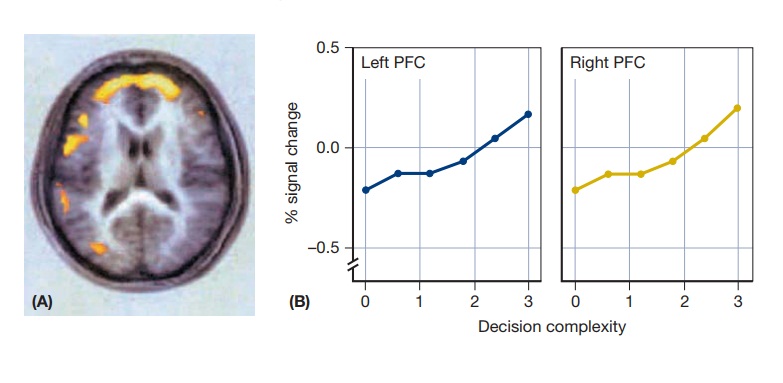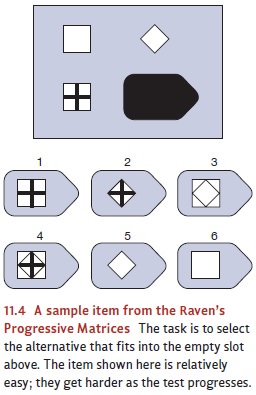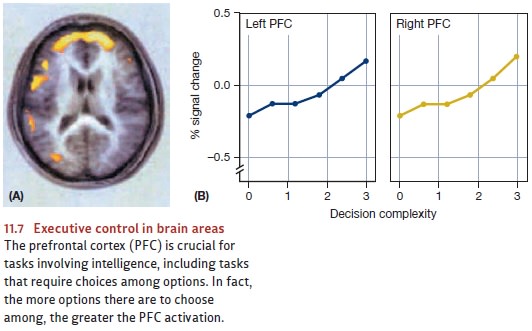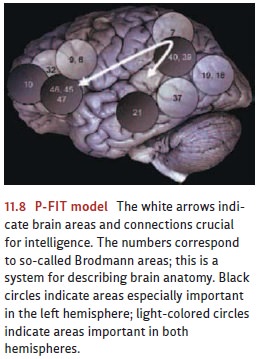Chapter: Psychology: Intelligence
The Building Blocks of Intelligence

THE BUILDING BLOCKS OF INTELLIGENCE
Let’s
pause to take stock. We’ve now seen that IQ scores are reliable predictors of
many important life outcomes; critically, the outcomes most closely linked to
IQ—success in school, for example, or success in complex jobs—are exactly the
sorts of things that should be
correlated with IQ if the IQ test is
measuring what it’s intended to measure:intelligence.
These
points prompted us to take a closer look at the IQ scores, and that’s what led
us to separate general intelligence (g)
from more specialized forms of mental ability. But can we take our analysis
further? What is it, inside a person, that gives them more g, or less? Do smart people have certain skills that the rest of us
don’t have? Do smart peo-ple have bigger brains, or brains with a different structure?
Let’s look at the evidence relevant to these points.
Mental Speed
Intelligence
tests require complex mental processes: The test taker has to detect
compli-cated patterns, work her way through multiple-step plans, and so on.
Each of these processes takes some time, and this invites the proposal that the
people we consider intelligent may just be those who are especially fast in
these processes. This speed would allow them to perform intellectual tasks more
quickly; it also would give them time for more
steps in comparison with those of us who aren’t so quick.
One
version of this hypothesis proposes that high-IQ people are faster in all
mental steps, no matter what the steps involve (Eysenck, 1986; Nettelbeck,
2003; Vernon, 1987). A related hypothesis proposes that high-IQ people are
faster not in all mental processes, but in just those needed for key mental
operations such as memory retrieval (E. Hunt, 1976, 1985b). In either case,
what could be the basis for this speed? One possibility is a greater degree of
myelination of the neurons in the brains of high-IQ people (E. Miller, 1994;
bear in mind that it’s the myelin wrappers around axons that allow fast
transmission of the neural impulse; axons without these wrappers transmit the
action potential much more slowly; for details). Alternatively, high-IQ people
may have a greater availability of metabolic “fuel” for the neurons (Rae,
Digney, McEwan, & Bates, 2003). But, no matter what the neural mechanism
might be, what is the evidence linking intelligence scores to measures of
speed?
A
number of studies have measured simple
reaction time, in which the participant merely responds as quickly as he
can when a stimulus appears. Others have measured choice reaction time, in which the participant must again respond
as quickly aspossible but now has to choose among several responses, depending
on the stimulus presented. In such tasks, reaction times are in fact correlated
with intelligence scores (note, though, that the correlation is negative, and
that lower times—indicating greater
speed—are correlated with higher IQ;
see, for example, Jensen, 1987).
Other
studies have focused on measures of inspection
time—the time someone needs to make a simple discrimination between two
stimuli (which of two lines is longer, or which of two tones is higher). These
measures correlate around ".50 with intelligence scores (see, for example, T. Bates &
Shieles, 2003; Dantiir, Roberts, Schulze, Wilhelm, 2005; Deary & Derr,
2005; Grudnik & Kranzler, 2001; Lohman, 2000; Petrill, Luo, Thompson, &
Detterman, 2001; again, the correlation is negative because lower response
times go with higher scores on intelligence tests).
The
suggestion, then, is that intelligent people may literally have brains that
operate more swiftly and more efficiently than the brains of less intelligent
people. This idea finds further support in a classic study that examined the
relationship between brain activity and someone’s ability to perform well on
the Raven’s Matrices, often used as a measure of g (see Figure 11.4). PET scans showed robust negative correlations between scores on theRaven’s test and
glucose metabolism in many areas distributed around the cortex (Haier et al.,
1988). In other words, the data showed less
energy consumption by the brains of people with higher IQs. This is certainly
consistent with the idea that high g
is somehow the product of more efficient brain function—as if smarter people
were simultaneously getting more “horsepower” as well as better “fuel economy”
out of their mental engine!

Working Memory and Attention
Mental
speed is likely to be one contributor to intelligence, but there are other
elements as well—including a central role for working memory capacity. To understand the point here, bear in mind
that many mental tasks involve multiple bits of information, and you need to
keep track of them as you proceed. In addition, many tasks involve multiple
steps, and they demand that you shift your focus from one moment to the
next—thinking about your overall goal for a second, to figure out what to do
next; then focusing on that next step, to deal with its specific demands; then
focusing once again on your goal, to choose the next step; and so on .
On
this basis, perhaps the people we call “intelligent” are those who have
particu-larly good working memories, so that they can hold onto the information
they need for complex tasks. They may also have especially good control of
their attention—so they’re able to coordinate their goals and priorities in an
appropriate way, first by focusing here
and then there, without getting lured
off track by distraction.
To
test this broad proposal, researchers have relied on measures that assess
someone’s working memory capacity (WMC;
e.g., Engle, Tuholski, Laughlin, & Conway, 1999). There are several
varieties of these measures; but in one common procedure, the participant is
asked to read aloud a brief series of sentences, such as
Due to his gross inadequacies, his
position as director was terminated abruptly.
It is possible, of course, that life did not arise on the Earth
at all.
Immediately
after reading the sentences, the participant is asked to recall the final word
in each one—in this case, abruptly
and all. Participants are tested in
this way with pairs of sentences (as in our example) and also with larger
groups of sentences—as many as 6 or 7. The aim, of course, is to find each
participant’s limit: What’s the largest group of sentences for which the participant
can do this read-and-recall task?
This
seemingly peculiar task provides a good measure of WMC because it involves
storing some material (the final words of sentences) for later use in the
recall test, while the person is simultaneously thinking about other material
(the full sentences, which have to be read out loud). This juggling of
processes, as we move from one part of the task to the next, is exactly how we
use working memory and attention in everyday life. Thus, performance on this
test is likely to reflect how efficiently a person’s working memory will
operate in more natural settings. And if, as hypothesized, this efficiency is
essential for intelligent performance, then these measurements of WMC should be
cor-related with intelligence.
The
data confirm this prediction. People with a larger WMC, measured as we’ve
described, do have an advantage on many other tests. For example, people with a
larger WMC do better on the verbal SAT, on tests of reasoning, on measures of
reading com-prehension, and on tests specifically designed to measure g (A. Conway et al., 2005; Gathercole
& Pickering, 2000a, 2000b; Daneman & Carpenter, 1980; Kane, Poole,
Tuholski, & Engle, 2006; LĂ©pine, Barrouillet, & Camos, 2005; Salthouse
& Pink, 2008).
Executive Control
How
exactly does a larger WMC improve intellectual performance? A number of
interrelated proposals have been offered; one proposal focuses on the
construction and maintenance of the task
model needed to perform a task. This model provides the “mental agenda”
that a person needs to carry out the task; the model is based on the person’s
understanding of the task’s goals, rules, and requirements as well as their
knowledge of the relevant facts. Once constructed, the model governs the
person’s mental steps as he works his way through the task.
Tasks
differ in the complexity of the model they require. The model will have to be
more complicated (for example) if task performance involves either multiple
goals or a sharp change in goals as certain cues come into view. Evidence
suggests that the ability to handle this complexity is strongly linked to
measures of g—so that higher-g individuals are able to maintain more
complex task models, allowing them to out-perform lower-g people whenever such models are required (J. Duncan et al.,
2008).
A
different (but related) proposal is that measures of WMC are actually measures
of each person’s executive control
over her own thoughts. This term—which we first met—refers to the processes
people use to launch mental actions, redirect their attention, or shift their
strategies. From this perspective, the link between intelligence and WMC
implies that smart people are literally in better control of their own thoughts
than less intelligent people are.
What
does executive control involve? Part of the answer lies in processes needed for
goal maintenance—the mental
activities that help us keep our goals in view, so that weconsistently direct
our behavior toward that goal. As we discussed, these activities seem to depend
on the frontmost part of the brain’s frontal lobe—the pre-frontal area (Figure
11.7). Damage to this brain site produces many problems, including goal neglect (in which the person fails
to keep track of the goal) and
perseveration (inwhich the person cannot make the necessary adjustment in
behavior when a goal changes).

Executive
control also requires other steps, rooted in other brain areas. For example,
the anterior cingulate cortex seems to play a key role in detecting conflict between dif-ferent mental
processes—including the conflict that will arise if one process is pulling
toward one goal while another process pulls toward a different goal (e.g.,
Botvinick, Cohen, & Carter, 2004; also Banich, 2009; Buckley, Mansouri,
Hoda, Mahboubi, Browning et al., 2009; Egner, 2008). Once these conflicts are
detected, this informa-tion feeds back to other mechanisms (probably in the
prefrontal area) that actually con-trol the flow of thoughts so that the
conflict can be addressed. (For more on the frontal lobe, see Koechlin &
Hyafil, 2007; for more on executive control, see J. Duncan, 1995; Gilbert &
Shallice, 2002; Kane & Engle, 2003; Kimberg, D’Esposito, & Farah, 1998;
Stuss & Levine, 2002.)
Notice
that both of these proposals—one emphasizing task models, one emphasizing
executive control—rely on claims about working memory (so that you can keep
your task model or your goals in mind). They also rely on claims about attention,

so
that you can focus on your task’s steps or on the relationship between those
steps and your current goal. Both proposals are thus fully compatible with the
so-called parieto-frontal integration theory (P-FIT) of intelligence suggested
by R .Jung & Haier (2007; Figure 11.8). This theory grows out of
neuroimaging studies that have compared the brains of individuals at differing
levels of intelligence; the theory iden-tifies a network of brain sites that
seem crucial for intellectual performance. As the theory’s name implies, some
of these brain sites are in the parietal lobe—sites crucial for the control of
attention; other sites are in the frontal lobe and are essential for working
memory. Still other important sites seem to play an important role in language
processing. The P-FIT conception emphasizes, though, that what really matters
for intelligence is the integration
of information from all of these sites, and thus the coordinated functioning of
many cognitive components. This is, of course, a biologically based proposal
that fits well with the functionally defined proposals emphasizing task models
and executive control.
Other Contributions to Intellectual Functioning
It
seems, therefore, that one part of what makes someone “intelligent” is simply
mental speed. This speed may make individual mental steps faster; it may also
allow better communication among distinct brain areas. What’s more, someone’s
working memory capacity and their ability to stay focused on a goal even in the
face of inter-ference or distraction also matters for intelligence. Related,
intelligence also may depend on the ability to construct and employ complex
task models; this ability is linked in turn to a higher degree of executive
control.
Beyond
these points, though, other factors also matter for intellectual performance.
For example, even if someone is slow, or has poor executive control, he can
benefit from the knowledge and skills he has gained from life experience. This
is, of course, the con-tribution from crystallized
intelligence, which helps people solve problems, draw sensible conclusions,
and make good decisions (also Ackerman & Beier, 2005; Hambrick, 2005).
The
performance of intellectual tasks is also powerfully shaped by attributes that
we might not think of as “intellectual” capacities. These include someone’s
motivation, her attitude toward intellectual challenges, and her willingness to
persevere when a prob-lem becomes frustratingly difficult. (Indeed, these
factors will be crucial for us later, when we turn to differences among various
groups in their average level of
performance on these tests.)
Plainly,
therefore, being intelligent requires a large and diverse set of attributes. If
we choose, in light of these points, to represent someone’s intelligence with a
single number—an IQ score—this seems both useful and potentially misleading.
This score does summarize someone’s performance, so it can be useful in
predicting how that per-son will perform in a wide range of other settings. At
the same time, this single number blurs diverse constituents together; and so,
if we wish to understand intelligence—and more important, if we want to find
ways to improve someone’s
intelligence—then we need to look past this single measurement and examine the
many components contributing to that score.
Related Topics